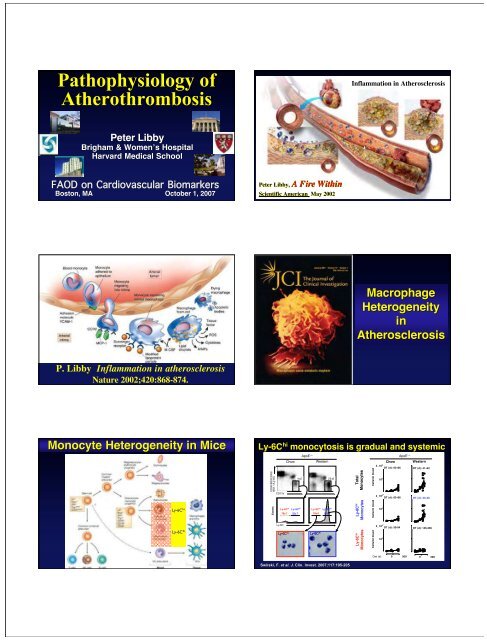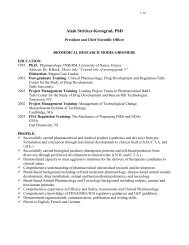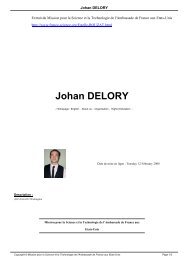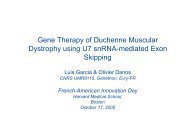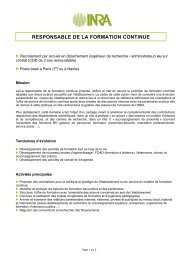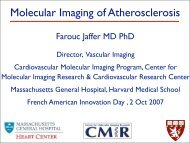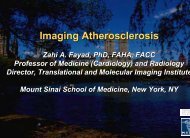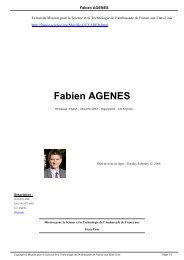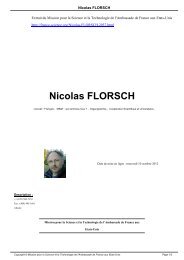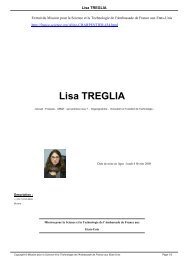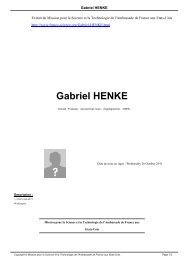Dr. Peter LIBBY
Dr. Peter LIBBY
Dr. Peter LIBBY
You also want an ePaper? Increase the reach of your titles
YUMPU automatically turns print PDFs into web optimized ePapers that Google loves.
Pathophysiology of<br />
Atherothrombosis<br />
Inflammation in Atherosclerosis<br />
<strong>Peter</strong> Libby<br />
Brigham & Women!s s Hospital<br />
Harvard Medical School<br />
FAOD on Cardiovascular Biomarkers<br />
Boston, MA October 1, 2007<br />
<strong>Peter</strong> Libby, A Fire Within<br />
Scientific American May 2002<br />
Macrophage<br />
Heterogeneity<br />
in<br />
Atherosclerosis<br />
P. Libby Inflammation in atherosclerosis<br />
Nature 2002;420:868-874.<br />
Monocyte Heterogeneity in Mice<br />
Ly-6C lo<br />
Ly-6C hi<br />
Ly-6C hi monocytosis is gradual and systemic<br />
CD90/B220/DX5/<br />
NK1.1/Ly-6G<br />
Events<br />
CD11b<br />
Ly-6C<br />
78± 7<br />
Ly-6C lo<br />
Chow<br />
ApoE –/–<br />
4 ±2 25±5<br />
19± 6<br />
Ly-6C hi<br />
Western<br />
Ly-6C lo Ly-6C hi Ly-6C lo Ly-6C hi<br />
lo<br />
22± 7 81± 6<br />
Total<br />
Monocytes<br />
Ly-6C hi<br />
Monocytes<br />
Ly-6C lo<br />
Monocytes<br />
Cells/ml blood<br />
Cells/ml blood<br />
Cells/ml blood<br />
2_10 6<br />
10 6 0<br />
2_10 6<br />
10 6 0<br />
2_10 6<br />
10 6 0<br />
Chow<br />
DT (d): 63–86<br />
DT (d): 63–86<br />
DT (d): 59-94<br />
ApoE –/–<br />
Western<br />
DT (d): 41–62<br />
DT (d): 33–38<br />
DT (d): 145-256<br />
Diet (d):<br />
0<br />
300<br />
0 300<br />
Swirski, F. et al. J. Clin. Invest. 2007;117:195-205
Mast Cells in Atherosclerosis<br />
Mast-cell deficiency mutes<br />
mouse atherogeneisis<br />
(26 weeks on an atherogenic diet)<br />
Libby P. Inflammation in Atherosclerosis Nature 420:868 (2002)<br />
Sun et al., Nature Medicine June 2007<br />
Possible RolesR<br />
of Mast Cells in Atherothrombosis<br />
Inflammation<br />
in Atherosclerosis<br />
<strong>Peter</strong> Libby, A Fire Within<br />
Scientific American May 2002<br />
The traditional<br />
“plumber!s s view” of<br />
the complications of<br />
atherosclerosis
MIs often arise from<br />
non-critical stenoses<br />
! Post-thrombolysis<br />
angiography<br />
! Serial angiographic studies<br />
! Intravascular Ultrasound<br />
studies<br />
P Libby<br />
What mechanisms may<br />
cause acute coronary<br />
syndromes in the<br />
absence of critical<br />
stenosis?<br />
Four Mechanisms of Atherosclerotic Plaque Disruption<br />
Libby & Théroux, Circulation, 2005<br />
Fibrous<br />
Cap<br />
M.L. Higuchi<br />
Lipid Core<br />
Thrombus<br />
Plaque<br />
Rupture<br />
Structural Integrity of the<br />
Plaque!s s Fibrous Cap<br />
• Depends on interstitial<br />
collagen fibrils (types I<br />
& III) synthesized by<br />
smooth muscle cells<br />
Interstitial Collagenases<br />
MMP-1, MMP-8, & MMP-13<br />
3/4 fragment<br />
Gly 775 - Leu/Ile<br />
776<br />
1/4 fragment<br />
Type I<br />
Collagen<br />
Cleaved<br />
Type I<br />
Collagen<br />
Neoepitope
Cleaved Collagen Colocalizes with MMP-1 &<br />
MMP-13 in Human Atheroma<br />
lumen<br />
lumen<br />
cleaved type I collagen<br />
lumen<br />
MMP-1<br />
type I collagen<br />
lumen<br />
MMP-13<br />
GK Sukhova et al.<br />
Circulation 99:2503 (1999)<br />
Collagenase 3<br />
Cell Type<br />
(MMP-8)<br />
Inflammation and the integrity<br />
of the plaque!s fibrous cap<br />
Lipid core<br />
Synthesis<br />
IL-1<br />
TNF-"<br />
MCP-1<br />
M-CSF<br />
IFN-#<br />
–<br />
CD-40L<br />
+<br />
+ + + +<br />
Breakdown<br />
Collagenase<br />
Gelatinases<br />
Stromelysin<br />
Other proteases<br />
+ pepidases<br />
+<br />
Fibrous<br />
Cap<br />
After Libby P. Circulation 1995<br />
Collagenase-resistant mutant mice<br />
•Mutation at the specific collagenase cleavage<br />
site on type I collagen (“knock-in”)<br />
collagenase cleavage site<br />
GLY (775) - ILE (776)<br />
GLY (775) - PRO (776)<br />
(Zhao W, Byrne MH, Boyce BF, Krane SM. JCI 1999)<br />
Collagenase-resistance promotes collagen<br />
accumulation in mouse atheroma<br />
Picro-sirius red staining with<br />
polarization<br />
Col +/+ / apoE -/- Col R/R / apoE -/-<br />
Fukumoto, Deguchi, Libby, Rabkin, Sakata, Chin, Hill, Lawler, Varo, Schoen, Krane, Aikawa<br />
Circulation 2004;110:1953<br />
MMP-13/collagenase<br />
collagenase-3 deficiency increases<br />
fibrillar collagen in mouse atheromata<br />
Mmp-13<br />
+/+ /apoE<br />
-/- Mmp-13<br />
-/- /apoE<br />
-/-<br />
Bright-field illumination<br />
Mmp-13<br />
+/+ /apoE<br />
-/- Mmp-13<br />
-/- /apoE<br />
-/-<br />
Polarized light<br />
Picrosirius red staining<br />
Slide 33<br />
Deguchi et al. Circulation 2005; 112:2708<br />
(mm 2 )<br />
Collagen area<br />
0.2<br />
p
Plaque rupture with thrombosis<br />
Thrombus<br />
Fibrous<br />
cap<br />
Thrombosis on a disrupted<br />
atheroma, the cause of most acute<br />
coronary syndromes, results from:<br />
FJ Schoen, BWH<br />
Lipid<br />
core<br />
• weakening of<br />
the fibrous cap<br />
thrombogenicity<br />
of the lipid core<br />
CD40 and Tissue Factor in Atheroma<br />
Molecular Biology of the<br />
High-Risk Plaque<br />
Synthesis<br />
Breakdown<br />
IFN-#<br />
–<br />
Collagen-degrading<br />
Proteinases<br />
Fibrous<br />
cap<br />
CD40<br />
Tissue Factor<br />
Mach et al. Circulation. 1997;96:396.<br />
Lipid core<br />
CD-40L<br />
+<br />
After Libby P. Circulation 1995<br />
+ + + +<br />
+<br />
IL-1<br />
TNF-"<br />
MCP-1<br />
M-CSF<br />
Tissue Factor<br />
Procoagaulant<br />
!Does the Biology<br />
of Atherosclerosis<br />
Suggest Useful<br />
Biomarkers?<br />
Inflammation in Atherosclerosis<br />
Initiation<br />
Libby, Ridker, Maseri<br />
Circulation 2002;<br />
105:1135-1143<br />
Progression<br />
Complication
A New View of<br />
Vascular Diseases<br />
!Inflammation: a putative<br />
“unified theory” of<br />
atherosclerosis<br />
pathogenesis<br />
Translation of the basic<br />
science to the clinic:<br />
!Can we use<br />
inflammatory markers<br />
to sharpen<br />
cardiovascular risk<br />
prediction?<br />
Pro-Inflammatory Pathways<br />
ICAM-1<br />
Selectins, HSPs, etc.<br />
Endothelium<br />
and other cells<br />
after Libby, Ridker.<br />
Circulation 1999;100:1148–1150.<br />
Pro-Inflammatory Risk Factors<br />
Primary Pro-Inflammatory Cytokines<br />
( e.g., IL-1, TNF-" )<br />
IL-6<br />
“Messenger” Cytokine<br />
Circulation<br />
CRP<br />
SAA<br />
Liver<br />
Human<br />
endothelial<br />
cells express<br />
the interleukin-<br />
1$ gene<br />
inducibly<br />
Endotoxin and tumor<br />
necrosis factor induce<br />
interleukin-1 gene<br />
expression in adult<br />
human vascular<br />
endothelial cells<br />
Libby et al. Am J Path<br />
124:179-186 (1986)<br />
Human smooth<br />
muscle cells<br />
express the<br />
Tumor<br />
Necrosis<br />
Factor " gene<br />
inducibly<br />
Warner SJC, Libby P.<br />
Human vascular smooth<br />
muscle cells: Target for and<br />
source of tumor necrosis<br />
factor. J Immunol<br />
1989;142:100-109.<br />
Pro-Inflammatory Pathways<br />
ICAM-1<br />
Selectins, HSPs, etc.<br />
Endothelium<br />
and other cells<br />
after Libby, Ridker.<br />
Circulation 1999;100:1148–1150.<br />
Pro-Inflammatory Risk Factors<br />
Primary Pro-Inflammatory Cytokines<br />
( e.g., IL-1, TNF-" )<br />
IL-6<br />
“Messenger” Cytokine<br />
Circulation<br />
CRP<br />
SAA<br />
Liver
VCAM-1 expression in rabbit aorta<br />
3 weeks on atherogenic diet<br />
Pro-Inflammatory Pathways<br />
Pro-Inflammatory Risk Factors<br />
ICAM-1<br />
Selectins, HSPs, etc.<br />
Endothelium<br />
and other cells<br />
Primary Pro-Inflammatory Cytokines<br />
( e.g., IL-1, TNF-" )<br />
IL-6<br />
“Messenger” Cytokine<br />
Circulation<br />
CRP<br />
SAA<br />
Liver<br />
Li et al. Arteriosclerosis 13:197; 1993<br />
after Libby, Ridker.<br />
Circulation 1999;100:1148–1150.<br />
Proliferating or<br />
interleukin-1<br />
activated human<br />
vascular smooth<br />
muscle cells<br />
secrete copious<br />
interleukin-6.<br />
Loppnow H, Libby P.<br />
J Clin Invest<br />
1990;85:731-738.<br />
CD40/ CD40 Ligand Dyad<br />
• Expressed on many cells<br />
including lymphocytes,<br />
macrophages, endothelial,<br />
and VSMC<br />
• Activation increases<br />
expression of CAMs,<br />
Chemokines, Cytokines,<br />
MMPs, Tissue Factor….<br />
• Interruption of the Dyad limits<br />
athero and lipid content in<br />
mice<br />
CD40<br />
S. Kinlay 2002<br />
CD40L<br />
(CD154)<br />
Schonbeck U, Libby P. Circ Res 2001; 89:1092-1103<br />
Functional CD 40<br />
ligand is expressed<br />
on vascular<br />
endothelial cells,<br />
smooth muscle<br />
cells, and<br />
macrophages in<br />
human atheroma<br />
Mach F, Schönbeck U,<br />
Sukhova GK, Bourcier T,<br />
Bonnefoy J-Y, Pober JS, Libby P.<br />
PNAS 94:1931 (1997)<br />
Interruption of CD40 signaling in<br />
hypercholesterolemic mice:<br />
• Inhibits the formation of<br />
atherosclerotic lesions<br />
• Prevents the evolution of<br />
established atheroma<br />
• Fosters features of the plaque<br />
associated with stability
Platelets Release Soluble CD40 Ligand<br />
CD40L<br />
S. Kinlay 2002 S. Kinlay 2002<br />
Inflammation Biology of the<br />
High-Risk Plaque<br />
Synthesis<br />
Breakdown<br />
Unstimulated<br />
Platelets<br />
Stimulated<br />
Platelets<br />
• Activated platelets are a<br />
rich source of sCD40L<br />
• Statins may lower sCD40L<br />
levels<br />
sCD40L<br />
Andre P, et al. Circulation 2002; 106:896<br />
Schonbeck U, et al. Circulation 2002; 106:2888<br />
IFN-#<br />
Lipid core<br />
CD-40L<br />
+<br />
After Libby P. Circulation 1995<br />
–<br />
Matrix-Degrading<br />
Proteinases<br />
+ + + +<br />
+<br />
IL-1<br />
TNF-"<br />
MCP-1<br />
M-CSF<br />
Tissue Factor<br />
Procoagulant<br />
Fibrous<br />
cap<br />
Matrix Metalloproteinase-9 in<br />
Human Atheroma<br />
Galis et al. J Clin Invest 94:2493 (1994)<br />
Matrix<br />
metalloproteinase<br />
activity<br />
in extracts<br />
of human<br />
atheroma<br />
J Clin Invest<br />
94:2493 (1994)<br />
Plasma concentrations and<br />
genetic variation of matrix<br />
metalloproteinase 9 and<br />
prognosis of patients with<br />
cardiovascular disease<br />
Blankenberg, Rupprecht, , Poirier, Bickel,<br />
Smieja, Hafner, , Meyer, Cambien, Tiret;<br />
AtheroGene Investigators.<br />
Circulation. 2003;107:1579-85.<br />
1127 CAD Pts<br />
Plasma concentrations and genetic variation of matrix metalloproteinase 9<br />
and prognosis of patients with cardiovascular disease. Blankenberg et al.<br />
AtheroGene Investigators. Circulation. 2003;107:1579-85.
Inflammation Biology of the<br />
High-Risk Plaque<br />
Synthesis<br />
IFN-#<br />
Lipid core<br />
CD-40L<br />
+<br />
After Libby P. Circulation 1995<br />
–<br />
+ + + +<br />
Breakdown<br />
Collagen-degrading<br />
Proteinases<br />
+<br />
IL-1<br />
TNF-"<br />
MCP-1<br />
M-CSF<br />
Fibrous<br />
cap<br />
Myeloperoxidase<br />
Superoxide<br />
Peroxynitrite<br />
Myeloperoxidase<br />
! An enzyme released by activated<br />
granulocytes and a monocyte<br />
subpopulation<br />
! Bound to extracellular matrix at<br />
sites of inflammation<br />
! Converts Cl - + H 2 O 2 to HOCl<br />
(hypochlorous acid), an oxidant and<br />
chlorinating species<br />
Macrophage myeloperoxidase regulation in<br />
human atherosclerosis: implications for<br />
acute coronary syndromes<br />
Inflammation and Thrombosis<br />
Activated platelets produce inflammatory modulators<br />
Platelet-derived growth factor<br />
Platelet factor 4<br />
CD 154 (CD40L)<br />
RANTES (PMN chemokine)<br />
Thrombospondin<br />
Transforming growth factor-$<br />
Nitric oxide<br />
Sugiyama et al. Am J Pathol 2001; 158:879-891<br />
Libby & Simon. Circulation 2001<br />
Croce &, Libby Curr Opin Hematol. 2007<br />
Study Objectives<br />
• To identify genes responsible for acute<br />
thrombotic complications of CAD<br />
(transcriptional profiling of STEMI vs.<br />
CAD)<br />
• To develop novel biomarkers for<br />
cardiovascular disease and new<br />
targets for therapy of atherosclerosis<br />
Transcriptional profiling:<br />
The causality problem<br />
Gene expression following acute MI may<br />
reflect either triggering events or<br />
downstream consequences of plaque<br />
rupture and thrombosis, thereby precluding<br />
definitive conclusions regarding causality.
The platelet transcriptome<br />
provides a snapshot in time<br />
Platelets circulate<br />
for ~ 7 days<br />
• Since platelets lack<br />
nuclear DNA, but<br />
retain megakaryocyte-<br />
derived mRNAs, , the<br />
platelet transcriptome<br />
provides a novel<br />
window on gene<br />
expression preceding<br />
acute coronary events.<br />
Normal<br />
(no CAD)<br />
Cardiac Catheterization Laboratory<br />
Brigham and Women’s s Hospital<br />
Stable<br />
Angina<br />
Unstable<br />
Angina<br />
STEMI<br />
RNA isolated from platelet-rich plasma from<br />
anticoagulated whole blood (up to 50-100<br />
ng/50 mL), amplified, and profiled<br />
Patients with ST-segment-elevation<br />
myocardial infacrction (STEMI) have higher<br />
plasma levels of MRP-14 than stable patients<br />
• In humans, MRP-14 exists primarily as the<br />
heterodimer MRP-8/14.<br />
• Neutrophil MRP-8/14 is secreted in response to<br />
inflammation and accumulates in plasma.<br />
• MRP-8/14 levels were increased in the plasma<br />
of patients presenting with STEMI vs. CAD,<br />
(median 17 mg/mL, IQR 14.8, 19.7) vs. (8.0<br />
mg/mL, IQR 5.0, 10.6;<br />
Healy et al. Circulation 2006;113:2278-2284<br />
Validation Phase:<br />
Women’s Health Study<br />
• Prospective, nested case-control study<br />
(255 case-control pairs) in population of<br />
apparently healthy post-menopausal<br />
women to assess the risk of first<br />
cardiovascular event (CV death, non-fatal<br />
MI, stroke) associated with base-line<br />
plasma levels of MRP-8/14.<br />
Ridker, PM et. al. NEJM 2005<br />
MRP-8/14<br />
independently<br />
predicts CV risk in<br />
the Womens’ Heath<br />
Study<br />
MRP-8/14 improved<br />
risk-prediction models<br />
based on total<br />
cholesterol:HDL or<br />
CRP testing alone.<br />
Healy et al. Circulation 2006;113:2278-2284<br />
Pro-Inflammatory Pathways<br />
ICAM-1<br />
Selectins, HSPs, etc.<br />
Endothelium<br />
and other cells<br />
after Libby, Ridker.<br />
Circulation 1999;100:1148–1150.<br />
Pro-Inflammatory Risk Factors<br />
Primary Pro-Inflammatory Cytokines<br />
( e.g., IL-1, TNF-" )<br />
IL-6<br />
“Messenger” Cytokine<br />
Circulation<br />
CRP<br />
SAA<br />
Liver
The dominant emerging<br />
biomarker of cardiovascular risk<br />
C-reactive protein: CRP


